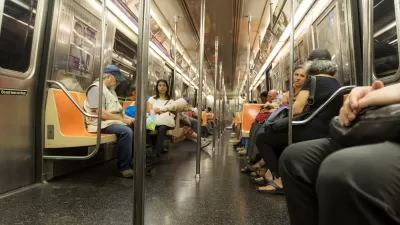Transit use is surging, but operators are facing the same fuel crunch as consumers and public monies for new investments aren't up to addressing the new demand.
"High gas prices are prying record numbers of Americans from their cars and onto buses, subways, and commuter trains. That has many pluses: It eases pocketbook expenses, road congestion, and pollution. But it's also straining providers of mass transit – a signal for needed change.
In Washington DC, the Metro subway and bus system is so stretched at peak hours that officials say the government and other large employers may have to mandate staggered work schedules if gas goes over $5 a gallon – once unimaginable.
In San Francisco and the Bay Area, seats near the doors of some BART trains have been removed to create more standing room for a surge in commuters. Meanwhile, about 20 percent of the nation's public bus operators have had to reduce service because of the high cost of diesel fuel, according to the American Public Transport Association (APTA).
Mass-transit ridership that's at its highest in 50 years presents an opportunity to beef up outdated systems in many areas of the country. But it's not going to be easy.
For starters, the same price pinch that's squeezing drivers is being felt by transit operators. They must pay more for fuel and their revenue sources are declining as the economy slows. More people may be exchanging traffic for tokens, but in some cases, fares cover as little as 20 percent of operating expenses. Mass transit depends greatly on local, state, and federal money – from sales taxes, for instance, which are slowing with the economy, and from gas taxes, which have not kept up with inflation.
As a result, public transit operators are increasing fares and delaying projects and improvements – just what the country doesn't need at a time of increased demand."
FULL STORY: For mass transit, mass investment

Manufactured Crisis: Losing the Nation’s Largest Source of Unsubsidized Affordable Housing
Manufactured housing communities have long been an affordable housing option for millions of people living in the U.S., but that affordability is disappearing rapidly. How did we get here?

Americans May Be Stuck — But Why?
Americans are moving a lot less than they once did, and that is a problem. While Yoni Applebaum, in his highly-publicized article Stuck, gets the reasons badly wrong, it's still important to ask: why are we moving so much less than before?

Research Shows More Roads = More Driving
A national study shows, once again, that increasing road supply induces additional vehicle travel, particularly over the long run.

Which US Rail Agencies Are Buying Zero-Emissions Trains?
U.S. rail agencies are slowly making the shift to zero-emissions trains, which can travel longer distances without refueling and reduce air pollution.

San Diego School District Approves Affordable Housing Plan
The district plans to build workforce housing for 10 percent of its employees in the next decade and explore other ways to contribute to housing development.

Lawsuit Aims to Stop NYC’s ‘City of Yes’ Zoning Reforms
A lawsuit brought by local lawmakers and community groups claims the plan failed to conduct a comprehensive environmental review.
Urban Design for Planners 1: Software Tools
This six-course series explores essential urban design concepts using open source software and equips planners with the tools they need to participate fully in the urban design process.
Planning for Universal Design
Learn the tools for implementing Universal Design in planning regulations.
City of Moreno Valley
Institute for Housing and Urban Development Studies (IHS)
City of Grandview
Harvard GSD Executive Education
NYU Wagner Graduate School of Public Service
City of Cambridge, Maryland
Newport County Development Council: Connect Greater Newport





























